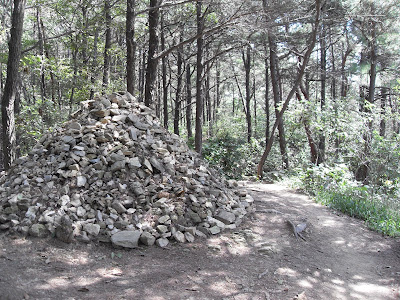 Our destination was located on the border of our town of Song-tan and the larger neighboring city of Anseong. As we approached the parking lot for the trail-head, we were both shocked at how popular this trail was. There were over a hundred cars in the designated lot, with massive overflow into the lot for the independence memorial across the road. This was definitely a serious destination, with its very own refreshment complex housing four restaurants and a great patio with a grotto and waterfall.
Our destination was located on the border of our town of Song-tan and the larger neighboring city of Anseong. As we approached the parking lot for the trail-head, we were both shocked at how popular this trail was. There were over a hundred cars in the designated lot, with massive overflow into the lot for the independence memorial across the road. This was definitely a serious destination, with its very own refreshment complex housing four restaurants and a great patio with a grotto and waterfall. While gearing up Mr. Pae explained that about three miles down the trail was our "destination," a small temple with a spring and public restrooms, which really peaked my interest. So with our enthusiasm high, and a supply of delicious sandwiches from Mrs. Pae, we headed off to a great adventure.
Well, after two miles of intense climbing we agreed that it was time for a well deserved break, and indulgence in the sandwiches so thoughtfully prepared. In addition to the ham, egg and cheese sandwiches, I was introduced to Mr. Pae's favorite drink, a black sesame and soy milk drink, which was slightly sweet, but more savory and had an enchanting and distinctly toasty sesame character.
Another 20 minutes of hiking brought us to our destination. Due to the heat and humidity that was supposed to have dissapered the week before, fatigue was starting to set in. We were in need of a re-supply of our water stores and a cool break. With our batteries a bit recharged from the spring, we finished the short climb up the hill to the temple, and began a little investigation.
 According to the information plaque, the temple was originally built in the 9th century and fully renovated in 1986, and is still in radiant condition. It intended function was to accommodate a fortress nearby, but its usefulness and beauty have endured. Of particular interest, was an exterior series of ten paintings documenting the path to enlightenment through the metaphor of a boy who lost his cow. I was particularly happy to have Mr. Pae along for this, as he seemed to derive as much interest in discovering its meaning and following the story of as myself. This temple also carried a theme of remarkably carved dragons in the rafters and gables, all carrying the famed "Dragon Ball (pearl)" which is said to symbolize the dragon's ability to grant wishes.
According to the information plaque, the temple was originally built in the 9th century and fully renovated in 1986, and is still in radiant condition. It intended function was to accommodate a fortress nearby, but its usefulness and beauty have endured. Of particular interest, was an exterior series of ten paintings documenting the path to enlightenment through the metaphor of a boy who lost his cow. I was particularly happy to have Mr. Pae along for this, as he seemed to derive as much interest in discovering its meaning and following the story of as myself. This temple also carried a theme of remarkably carved dragons in the rafters and gables, all carrying the famed "Dragon Ball (pearl)" which is said to symbolize the dragon's ability to grant wishes. The return trip was even more grueling than the initial trek. You see, I have become accustomed to the trails of the American West, which were predominately used originally for pack animals in the mining industry. To accommodate the loads, a rather "modern" technology was employed; switch-backs. It has been years since I did a significant hike that did not utilize switch-backs to mitigate the rate of ascent, and man alive was this a wake up call to how convenient they are. At one point, on the back side of this mountain, we gained 800' of elevation over a horizontal distance of only a quarter mile. That is a whopping 60% grade!!!!!!! It necessitated three breaks, and three soaked handkerchiefs.
The return trip was even more grueling than the initial trek. You see, I have become accustomed to the trails of the American West, which were predominately used originally for pack animals in the mining industry. To accommodate the loads, a rather "modern" technology was employed; switch-backs. It has been years since I did a significant hike that did not utilize switch-backs to mitigate the rate of ascent, and man alive was this a wake up call to how convenient they are. At one point, on the back side of this mountain, we gained 800' of elevation over a horizontal distance of only a quarter mile. That is a whopping 60% grade!!!!!!! It necessitated three breaks, and three soaked handkerchiefs. The adventure left me with a very satisfied sense of accomplishment when we finally returned to the trail head. Before departing, however, we made a brief detour to the independence memorial. It tells the history of the importance of Anseong in the "March First Movement" of 1919. These were the first riots in opposition to the oppressive occupation of Korea by the Japanese. The brutality of the Japanese displayed in the history of the occupation is blood chilling. The independence of the Koreans is as hard fought and dear to them as any free nation, and I am proud to serve in the defense of its continuation.








































